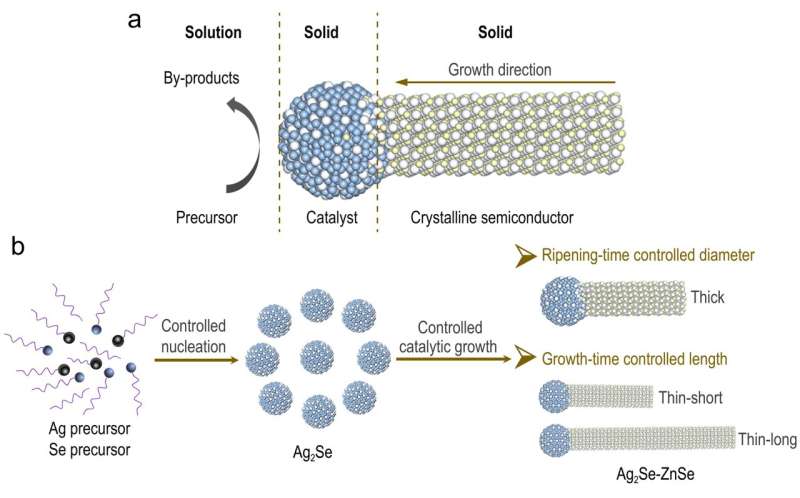A pathway to high-quality ZnSe quantum wires

One-dimensional semiconductor nanowires with strong quantum confinement effect—quantum wires (QWs)—are of great interest for applications in advanced optoelectronics and photochemical conversions. Beyond the state-of-the-art Cd-containing ones, ZnSe QWs, as a representative heavy-metal-free semiconductor, have shown the utmost potential for next-generation environmental-friendly applications.
Unfortunately, ZnSe nanowires produced thus far are largely limited to the strong quantum confinement regime with near-violet-light absorption or to the bulk regime with undiscernible exciton features. Simultaneous, on-demand, and high-precision manipulations on their radial and axial sizes—that allows strong quantum confinement in the blue-light region—has so far been challenging, which substantially impedes their further applications.
In a new article published in the National Science Review, a research team led by professor YU Shuhong at University of Science and Technology of China (USTC) has reported the on-demand synthesis of high-quality, blue-light-active ZnSe QWs by developing a flexible synthetic approach—a two-step catalytic growth strategy that enables independent, high-precision, and wide-range controls over the diameter and length of ZnSe QWs. In this way, they bridge the gap between prior magic-sized ZnSe QWs and bulk-like ZnSe nanowires.
The researchers found that a new epitaxial orientation between the cubic-phase catalyst tips and wurtzite ZnSe QWs kinetically favors the formation of ultrathin, stacking-fault free QWs. The strong quantum confinement, high-degree size control, and the absence of mixed phases together lead to their well-defined, ultranarrow excitonic absorption in the blue-light region with full width at half maximum (FWHM) of sub-13 nm. After surface thiol passivation, they further eliminated the surface electron traps in these ZnSe QWs, resulting in long-lived charge carriers and high-efficiency solar-to-H2 conversion.
The two-step catalyzed growth strategy is believed to be general for a variety of colloidal nanowires. The access to those high-quality nanowires would thus offer a versatile material library for heavy-metal free applications in solar fuels and optoelectronics in the future.
Two-photon absorption and stimulated emission in poly-crystalline zinc selenide with femtosecond laser excitation
Yi Li et al, On demand defining high-quality, blue-light-active ZnSe colloidal quantum wires, National Science Review (2022). DOI: 10.1093/nsr/nwac025
Citation:
A pathway to high-quality ZnSe quantum wires (2022, April 8)
retrieved 8 April 2022
from https://phys.org/news/2022-04-pathway-high-quality-znse-quantum-wires.html
This document is subject to copyright. Apart from any fair dealing for the purpose of private study or research, no
part may be reproduced without the written permission. The content is provided for information purposes only.
For all the latest Science News Click Here
For the latest news and updates, follow us on Google News.

